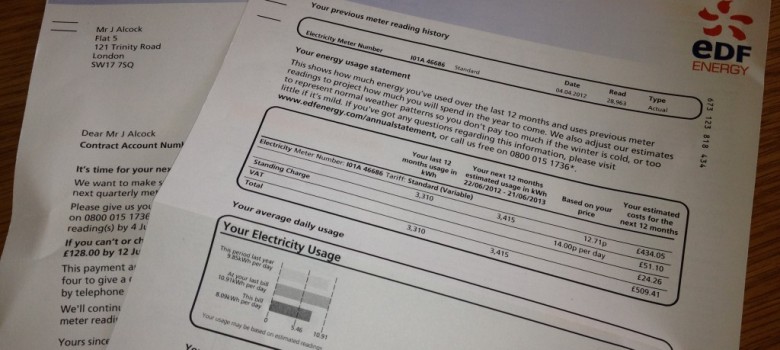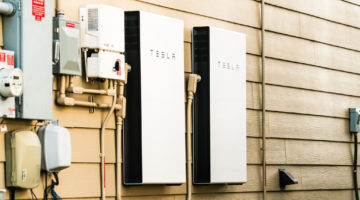
Before I got involved in TheGreenAge, it is fair to say that my electricity bill would arrive on a quarterly basis and I would eventually reluctantly pay it without really ever looking at it. I knew that in the winter my bills would be higher and during the summer months these would come down a bit.
The purpose of this blog is to make you a little bit more aware of how the electricity companies decide how much to bill you (it is not simply a finger in the air job surprisingly!!), and give you a little background on the Energy Mix in the UK (i.e. the sources of electricity that electricity providers use).
What is a Watt?!
A light bulb in your home is measured in watts, which is a rate (like miles / hour) rather than a quantity. A Watt is equal to the number of joules used per second and is a measurement of power, for example, a 50 watt incandescent light bulb uses 50 watts of power, so 50 joules / second, where as an equivalent energy saving light bulb potentially may only use 13 watts. The rate at which power is used by an appliance is not really helpful for making energy usage comparisons, instead we use a quantity measure.
What is a Kilowatt Hours
A kilowatt hour (denoted kWh) is the quantity measure that we use and is simply the number of watts (divided by 1000 to make it Kw) used in one hour. You will notice if you have a look at your utility bill it gives you the amount owed based on the number of kWh used over a certain period. Elsewhere on TheGreenAge we have stated that an average house uses 4500kWh of energy per year. Looking at the electricity bill for my flat, we used 3100kWh of electricity last year at a rate of £0.1271 / kWh. Therefore the amount I actually pay is simply the quantity multiplied by the charge / kWh (just shy of £400).
Understanding your Electricity Bill
So how does my supplier decide to charge me £0.1271 / kWh of electricity? It is a very specific number after all. Well they take the weighted average of all the different sources of electricity that they use, multiplied by the rate for each. For instance EDF source 61.8% of their electricity from nuclear, 27.9% of electricity from coal and so forth (only 3.9% from renewable at the moment!!).
But imagine (to make the maths easy) 60% came from nuclear, 30% from coal and the final 10% from renewable.
If energy from nuclear cost 15p / kWh, coal cost 10p / kWh, and renewables 18p / kWh, the calculation would be
( (60 x 0.15) + (30 x 0.10) + (10 x 0.118) ) = 13.8 p / KWh
Below I have included a table that details the energy mix from each of the big 6 energy suppliers (with some greener energy providers).
Each of the different sources will have different £/kWh associated with them. Renewable on the table above will obviously have many different costs associated with it, as the £/kWh varies for solar power, wind power, hydroelectric and so forth.
As you can see in the UK, for the period April 2010 – March 2011, just under 8% of the electricity used in the UK came from renewable sources, with EDF the lowest contributor (although depending on your views of nuclear – this could somewhat be forgiven). There are also energy suppliers that will supply you exclusively green energy, although as the £/kWh for green energy tends to be higher (please see my blog on the Green Economy for reasons why!!), your utility bills will be at a premium.
The costs included in the £/kWh calculation
Unfortunately there is an added complication, when you look at the figure – e.g. 12 pence / kWh, it is not only the fuel costs that make up the 12 pence. The fuel component makes up between 60 – 80% of the bill. In addition however there are various other costs, including infrastructure costs which include things like energy loss in transmission from the power station through all the transmission lines and finally into your house. There are also cost to serve costs, which include the IT systems for managing bills, and electricity company wages and so forth. The cost to serve costs, Infrastructure costs and the energy cost equal about 70-80% of your total bill.
The remaining 20-30% of the pence / kWh, are known as Pass Through Charges. These include the standing charge, which tends to be a fixed cost split over the billing period that goes towards the installation and maintenance of the electricity distribution network. In addition things like the settlement agency charge (meter reading companies wages etc) go through the pass through charges.
The Cost of Generating Electricity
All the ‘Big 6’ energy suppliers are publically listed companies; therefore they are all directly responsible to their shareholders. As a result they are all trying increase shareholder value, which in the utility business is being able to buy / produce energy at the lowest possible cost, and then sell it at the highest possible price they can without affecting demand.
The electricity that you or I pull from the electric plug sockets in our houses obviously is the same regardless of what source it comes from. So it makes sense that the companies focus on the energy sources with the cheapest £/kWh, but what are they?
Well coal (unfortunately) is currently about the cheapest source of electricity, followed by hydroelectric, nuclear, gas, then wind and finally solar. However, while fossil fuel kWh have remained relatively constant, they can only go up as supply diminishes and a value is put onto carbon emissions. Meanwhile, the prices of solar PV and wind are dropping dramatically as the technology improves and economies of scale come into play.
Flexibility by Source
The other thing that the electricity companies need to take into account is being able to provide electricity even when there are sudden peaks in demand. Well the theory behind matching supply and demand of electricity is relatively simple. More inflexible sources such as nuclear power, which take days to bring online and produce power, are on the whole time providing the base power to the energy mix. More flexible sources are used such as gas to match regular peaks in demand (gas power plants can come on line in minutes) like when the average 9-5 worker gets home.
But what do the utility companies do to meet unusual sudden peaks in demand? For example half time of TV soaps, or half time of the football world cup final, when people all suddenly put on the kettle at the same time to make a cup of tea. Well, the energy grid takes advantage of things liked pump storage.
In pumped storage, water is pumped up to a high reservoir using cheap excess electricity (like during the middle of the night). When these sudden surges in demand take place, the plant is switched on allowing the water to fly down through the turbines via gravity, producing electricity. In the case of the Dinorwig power plant in Wales, from producing no electricity at all to maximum output takes only12 seconds.
Adding complexity to the supply /demand on the grid is the current push for low emission green energy sources like solar and wind. The issue is that these sources are intermittent, only producing electricity when the sun shines or wind blows, so the grid will have to become a lot more flexible to cope with their input into the grid. The smart grid is at the forefront of fully integrating these sources into our electricity mix going forward.
So what steps can you take to lower your bill?
I hope this blog has provided you with a little insight on not only your bill, but why you get charged every quarter the amount you do, and how the utility companies are trying to manage the grid. As always, I implore all of you to look very seriously at maximising energy efficiency measures installed in your house such as insulation and energy saving lightbulbs, as these will lower your bills.
Also with much of our base power going offline in the next 10 years or so (with nuclear plants being decommissioned), now is the perfect time to install your own solar panels / wind turbines or even micro hydro electric (if possible) to generate your own electricity. This will not only lower your bills even further, but also will reduce you reliance on a grid, which currently does not look as if it will be able to keep up with ever growing demand in the years to come.
Author: James Alcock













No Comments yet! Be the first one.